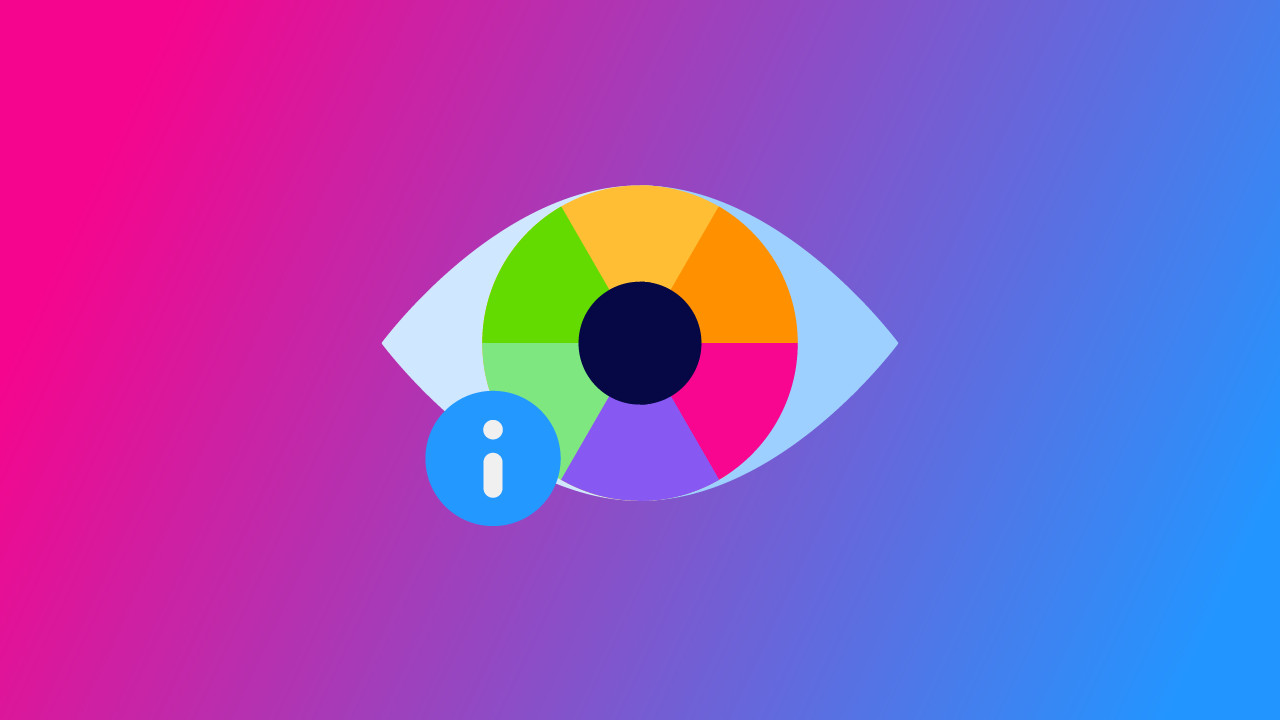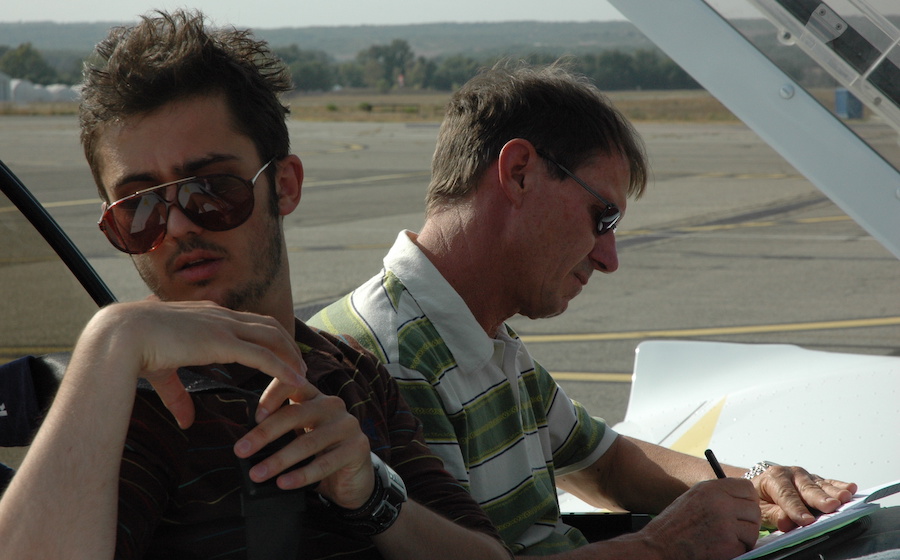-
Key Takeaways
-
How Does Color Vision Work?
- The Cones
- Wavelengths
-
What Is Color Blindness?
-
What Causes Color Blindness?
- Inherited Color Blindness
- Acquired Color Blindness
- Types of Color Blindness
- Red-Green Color Blindness
- Blue-Yellow Color Blindness
-
Why Is Color Vision Important?
- Color Vision in Aviation
- Safety Context
-
Color Vision Testing (Updated for 2025)
- FAR Part 67 and Color Vision
- Obtaining a Medical Certificate
- Removing The Color Vision Restriction
- Legacy OCVT/MFT
- Aeromedical Tourism
-
A Step-by-Step Guide to Removing Your Color Vision Restriction
- Step 1
- Step 2
- Step 3
- Step 4
-
FAA Testing Update: No Online Plates
-
Correcting Color Vision Issues
-
The Future of Color-Blind Aviators
- Part 107 & Color-Vision
-
Conclusion
Approximately 1 in 12 men and 1 in 200 women have issues with color perception. Historically, even those with slight color vision impairment were denied the opportunity to fly.
With advancements in color vision testing, times have changed. It is possible to obtain a pilot license while color-blind and even become an airline pilot, depending on the degree of color vision impairment.
To understand the process of becoming a color-blind aviator, we must examine the importance of color vision and why color blindness is not a one-size-fits-all condition.
Key Takeaways
- Pass one approved CBT (CAD, RCCT, or CCVT) for no restriction.
- Online or printed plates don’t count after Jan 1, 2025.
- If you don’t pass: Third-Class #104; try another approved test.
- LOE/SODA still valid; higher classes must meet current standards.
How Does Color Vision Work?

Your eyes contain two distinct types of sensory cells:
- Rods
- Cones
The rods are essential for night vision and are sensitive to changes in brightness.
The cells that provide color perception are the cones, and they are the key to understanding color vision and color vision deficiencies.
The Cones
The cones are found in three different types, each responsible for the perception of different wavelengths:
- Blue Light – S-Cones: Known as “short-cones,” they react to shorter wavelengths.
- Green Light – M-Cones: Following the same naming convention, these cones react to medium wavelengths.
- Red Light – L-Cones: These cones react to longer wavelengths.
Molecules in the cones, known as photopigments, are responsible for converting light into chemical signals.
Wavelengths
Different surfaces reflect different wavelengths. For example, if a surface only reflects short wavelengths, the surface will be perceived as blue by the brain through the s-cones.
Colors between blue, green, and red are merely a mixture of different wavelengths being reflected off of a surface. If all wavelengths are reflected simultaneously, your brain will perceive the color white.
Surfaces do not only reflect wavelengths, they also absorb them, which changes the perceived color. Perceived color depends, therefore, on the strength and mixture of light wavelengths reflected and absorbed by a surface.
What Is Color Blindness?
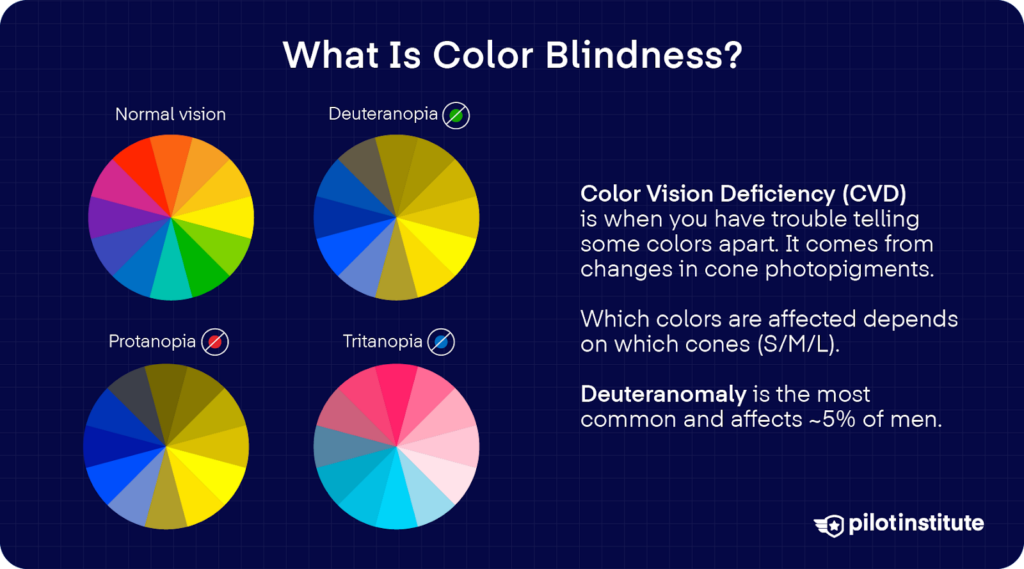
Color blindness, often referred to as Color Vision Deficiency (CVD) is a decreased ability to perceive and distinguish between colors. This occurs due to faulty photopigments in the cones.
The degree and type of color blindness depend on which cones and their associated photopigments are faulty.
Deuteranomaly is the most common type of color blindness and affects 5% of males. This color deficiency is due to faulty photopigments in the m-cones, responsible for a green light. With this color vision deficiency, yellow and green appear redder, and distinguishing blue from violet is difficult.
Issues regarding color blindness are generally minor despite no available cure. Achromatopsia, also known as total color blindness, is far rarer, with an estimated 1 in 30,000 individuals affected.
What Causes Color Blindness?
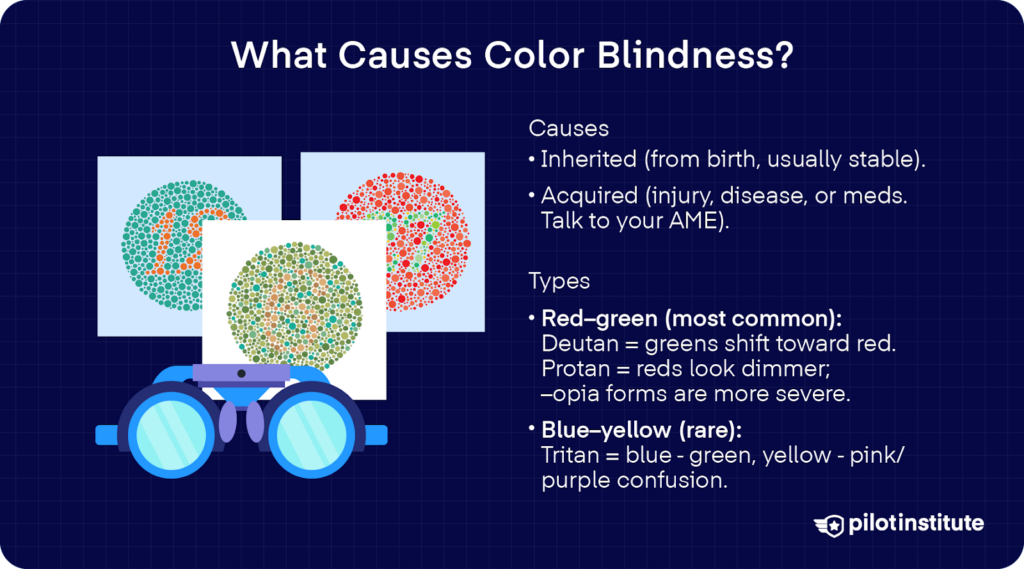
Color deficiencies are classified based on two different causes:
- Inherited
- Acquired
Inherited Color Blindness
Inherited color blindness is present from birth and is the most common cause of color vision deficiency.
Inherited color blindness is genetic and is most often caused by mutated or missing genes affecting the photopigments in the cones.
As our understanding of the human genome advances, mutations that cause color-blindness that does not affect photopsin (photoreceptor) genes have been discovered. Our understanding of the genetics behind color vision deficiency is continuing to evolve.
Most inherited color vision deficiencies do not develop or worsen over time and often materialize from birth or early childhood.
Acquired Color Blindness
Acquired color blindness can be acute (short-term) or, less commonly, chronic (long-term).
Acquired color blindness is generally caused by physical trauma to the eye or degenerative diseases. Color deficiency can also be caused by specific prescription drug medications.
While it is certainly possible to obtain a pilot certificate with acquired color blindness, you will likely have to undergo additional medical testing to establish the extent of your color deficiency and whether it is likely to worsen in the future.
Types of Color Blindness
While red-green color vision deficiency is the most common, there are many other types of color vision deficiency.
Color vision deficiency can be classified as follows:
- Red-Green Color Blindness
- Blue-Yellow Color Blindness
Red-Green Color Blindness
There are four types of red-green color blindness:
- Deuteranomaly:
- This is the most prevalent type of color vision deficiency. Deuteranomaly causes green to appear redder. This color blindness is often mild and does not generally interfere with everyday activities.
- Protanomaly:
- Red appears dimmer and more brownish; reds and greens are more easily confused. This type is also mild and does not generally interfere with everyday activities.
- Protanopia & Deuteranopia:
- Severe red-green deficiencies causing marked difficulty distinguishing red/green; protanopia also makes red lights appear dimmer.
Blue-Yellow Color Blindness
Blue-yellow color vision deficiency is less common. This type of color blindness makes it challenging to distinguish between blue and green, as well as between yellow and red.
There are two types of blue-yellow color blindness:
- Tritanomaly: Reduced blue-yellow discrimination.
- Tritanopia: Severe blue-yellow loss; blue↔green and yellow↔pink/purple confusions, colors look dimmer.
Why Is Color Vision Important?

We have so far established that color blindness comes in many forms, with varying degrees of severity. Most people with color vision deficiencies do not need to make any significant changes to their lifestyle, and their color blindness does not affect their day-to-day lives.
Why, then, is color vision considered crucial in aviation?
Color Vision in Aviation
Aviation is full of color-coded symbology, lights, and documentation.
Color is used to decode signals, receive visual cues at airports, and gather information from flight displays, among other things.
Color vision becomes particularly important at night when different colored lights often replace their white-labeled counterparts.
A few of the tasks that require aviators to distinguish between colors include:
- Reading instrumentation.
- Reading warning lights in the cockpit.
- Identifying aircraft at night, particularly regarding position and direction of travel.
- Identification of runway lights at night.
- Reading color-coded documentation and checklists.
Safety Context
A real-world example: the NTSB found the first officer’s color-vision deficiency was a contributing factor in the 2002 FedEx Flight 1478 accident at Tallahassee, alongside fatigue and procedural issues. It’s a clear reminder that color cues (PAPI/VASI, lights, displays) can be safety-critical.
Color Vision Testing (Updated for 2025)

Since January 1, 2025, AMEs have used approved, in-person computer-based tests for color vision, including CAD, RCCT, or Waggoner CCVT.
Printed plates and any virtual/downloaded/printed tests don’t count for pilots. If you pass one, you’re done! Screening is one-time for most pilots and isn’t repeated at renewals.
If you don’t pass, the AME issues a Third-Class medical with limitation #104 (“Valid for day VFR only”) if you’re otherwise qualified. You can attempt any of the approved tests again; passing any one removes the limitation.
To upgrade to Second/First-Class, pass an approved test or request a Color-Vision Limitation Review with the Federal Air Surgeon. Prior LOEs/SODAs remain recognized.
FAR Part 67 and Color Vision
FAR Part 67 states that to obtain a medical certificate, applicants must have “… the ability to perceive those colors necessary for the safe performance of airman duties.” This statement appears vague, and you’d be forgiven for not understanding what the FAA means by “perceive those colors necessary for the safe performance of airman duties.”
The truth is, as color vision testing has advanced, the FAA’s definition of “those colors” has changed.
To understand the specific color vision abilities that you will require to obtain certain medical certificates, we need to understand the FAA’s color vision testing standards.
Obtaining a Medical Certificate
See Color Vision Testing (Updated for 2025) for the current FAA process; your AME will apply that standard during your visit.
If testing occurs outside the AME’s office, the clinic must verify identity and provide a score printout for the AME to upload.
Removing The Color Vision Restriction
To remove a color-vision limitation, pass one of the FAA-approved computer-based tests:
• CAD (Aviation/Commercial version) — pass scores published by FAA
• RCCT (DoD version) — ≥55 for each of Red/Green/Blue
• Waggoner CCVT — see FAA table for the acceptable section scores
Passing any one removes the limitation; failure of one test doesn’t bar trying another.
Legacy OCVT/MFT
Before 2025, many pilots tried to remove color-vision limits with an Operational Color Vision Test (OCVT) and Color-Vision Medical Flight Test (MFT), which were often described as “one-shot” and high-stakes.
As of 2025, the FAA’s standard path is approved computer-based testing. Pilots may attempt any of the acceptable tests, and failure of one doesn’t bar trying another. Existing LOE/SODA holders keep their status, but new applicants and pilots seeking upgrades typically use the computer-based tests. Appeals go to the Federal Air Surgeon per the AME guide.
Aeromedical Tourism
An unfortunate trend has developed due to outdated testing standards for color vision deficiencies. Some pilots who fail to obtain a medical certificate due to color vision issues attempt to obtain medical certification in a different country and then convert their license back to their initial intended country. This is commonly known as “aeromedical tourism.”
This is due to different color vision testing standards across the world, even among ICAO license member states. ICAO provides no guidance on how member states should determine a passing threshold for color vision tests.
This practice is less common among FAA license holders but is more common in the rest of the world, where ICAO licenses are more easily converted.
Aeromedical tourism can be very expensive and is morally questionable, but it is a solution for individuals who are not fully color-blind.
A Step-by-Step Guide to Removing Your Color Vision Restriction

Things have changed a lot over the years, and now the process is much simpler than it was in the past.
Here are the steps:
Step 1
Take an approved, in-person computer-based test (CAD, RCCT, or Waggoner CCVT). If tested at a clinic, bring the printed score report.
Step 2
Pass = done (no routine retest). The AME issues your medical without a color-vision limitation. For most pilots, this is a one-time screening. No routine retest at renewals.
Step 3
Didn’t pass? You’ll receive Third-Class #104 (day VFR only) if otherwise qualified. Try another approved test. A pass removes the limit.
Step 4
Still seeking 1st/2nd Class but can’t pass a CBT? File a Color-Vision Limitation Review (appeal) with the Federal Air Surgeon. Prior LOE/SODA holders keep their status per the AME Guide.
FAA Testing Update: No Online Plates
Only in-person, FAA-approved computer-based tests now count for pilots’ color-vision screening. Virtual, downloaded, or printed Ishihara/plate tests are not accepted.
If testing is done outside the AME’s office, the testing clinic must verify identity and provide a score printout that the AME can upload.
Correcting Color Vision Issues
Color vision deficiency has no known cure as of yet. Instruments such as “color correcting glasses” have been developed that filter and block out specific wavelengths, allowing individuals with more common color blindness to have greater color perception.
The efficacy of color vision correcting glasses varies significantly between individuals, and they are not FAA-approved. This means that you cannot wear them when undergoing a color vision test.
The Future of Color-Blind Aviators
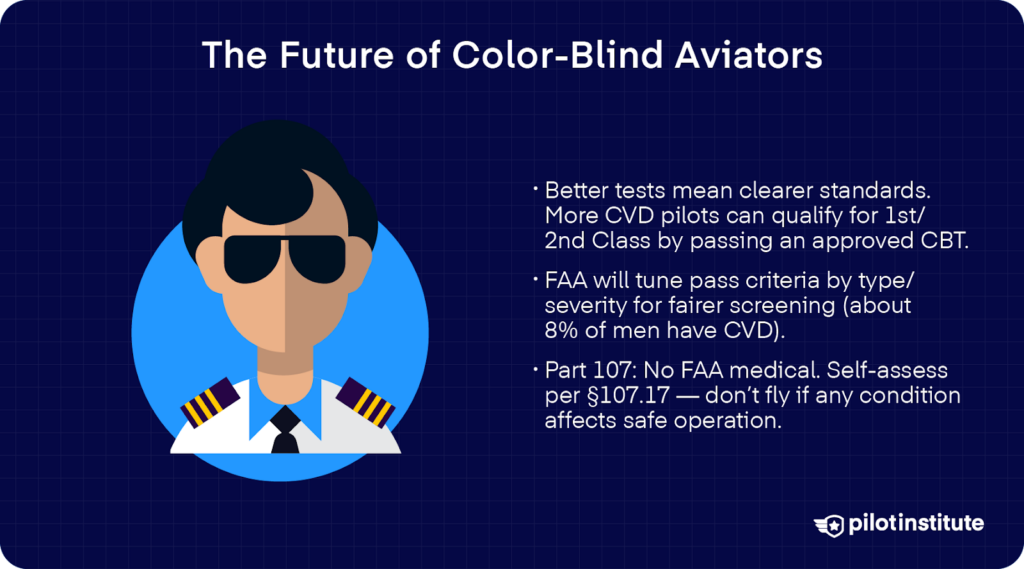
It is inevitable that as color vision testing improves, more color vision-deficient individuals will be able to receive Class 1 and Class 2 medical certificates.
Because of the variable and individual nature of color vision deficiency, it is challenging to create an objective pass/fail criteria. This is bound to change in the future. When more accurate and specific color vision testing is developed, strict but fair standards will be developed based upon the results of the accurate color vision deficiency test.
The FAA will be able to adjust testing pass criteria to filter out individuals with specific types and severities of color vision deficiency.
With approximately 8% of males experiencing some kind of color vision deficiency, it is imperative that the FAA allow as many individuals as possible to qualify and become aviators as demand continues to grow.
Part 107 & Color-Vision
Remote (Part 107) drone pilots do not need an FAA medical, so there’s no FAA color-vision test for Part 107 certification. You must still self-assess fitness: don’t fly if you have a condition that would interfere with safe operation.
Conclusion
Color vision doesn’t have to ground you. Today, the FAA uses in-person computer-based testing. Pass one approved test and you fly without a color-vision restriction. If you don’t pass, you’ll usually get Third-Class with #104 (day VFR only), and you can always try another test.
Your best next steps are to talk with your AME, book an approved CBT, and review how cockpit alerts, charts, and light signals look to you. If you already have an LOE or SODA, you keep it. If you need First or Second Class, follow your AME’s guidance or use the Federal Air Surgeon review path.
Prove you can read the colors that matter, and you can build the flying career you want.
